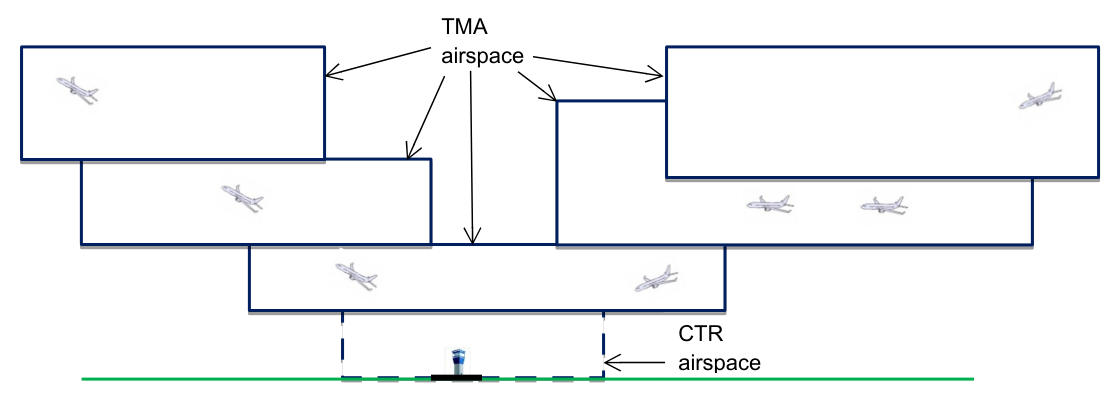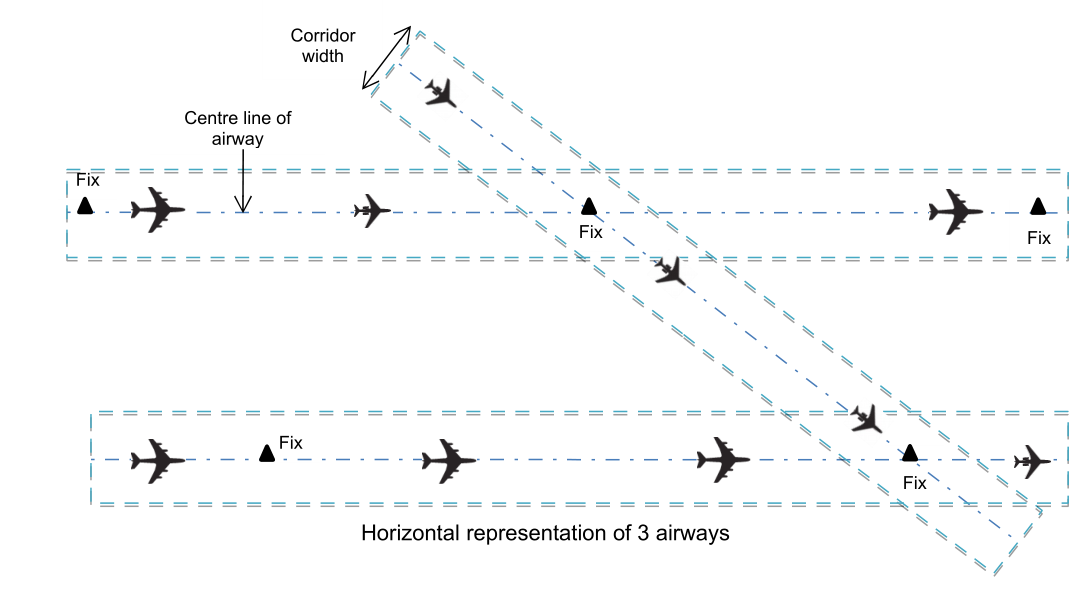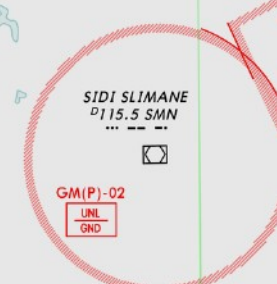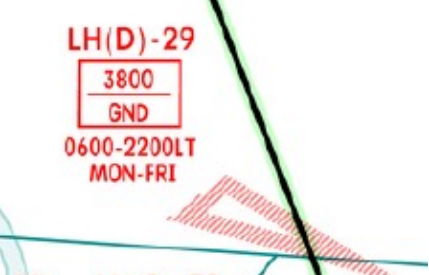¶ Introduction
In aeronautics, airspaces are the portion of the atmosphere controlled by a country above its territory.
There are two kinds of airspace:
- Controlled airspace is airspace of defined dimensions within which ATC service is provided to IFR flights and to VFR flights in accordance with the airspace classification.
- Uncontrolled airspace is airspace in which air traffic control does not exert any executive authority, although it may act in an advisory manner.
¶ Flight information region
A Flight Information Region (FIR) is an airspace of defined dimensions within which flight information service and alerting service are provided:
- Flight Information Service: A service provided for the purpose of giving advice and information useful for the safe and efficient conduct of flights.
- Alerting Service: A service provided to notify appropriate organizations regarding aircraft in need of search and rescue aid and to assist such organizations as required.
There is no standard size for FIRs -- it is a matter of administrative convenience of the countries concerned:
- One FIR for one medium country's airspace
- Several FIRs for one large country's airspace
- One FIR for several small country's airspace
In some cases there is a vertical division of the FIR, in which case the lower portion remains named as FIR, whereas the airspace above is named Upper Information Region or UIR.
An information service and alerting service are the basic levels of air traffic service, providing information pertinent to the safe and efficient conduct of flights and alerting the relevant authorities should an aircraft be in distress.
¶ Controlled airspace
Controlled airspaces contain several types like, CTR, CTA, TMA, ACC...
¶ Control zone (CTR)
A control zone named CTR or known as controlled traffic region is a controlled airspace, normally around an airport, which extends from the surface to a specified upper limit, established to protect air traffic operating to and from that airport.

This airspace is usually the airspace dedicated to a tower controller.
In certain countries, this airspace exists but it is not named CTR (like in the USA).
Do not confuse the term "CTR" with the controller position "ICAO_CTR"
¶ Control area (CTA)
A control area named CTA is a controlled airspace that exists in the vicinity of an airport, which extends from a lower level to a specified upper level. The lower level shall not be the ground. It usually is situated on top of a control zone and provides protection to aircraft climbing out from the airport.
A CTA can be formed by:
- Terminal control areas (TMA) of sufficient size to contain the controlled traffic around the busier aerodrome
- Interconnecting airways
- Area-type control areas for which specific ATS routes have been defined for the purpose of flight planning and which provide for the organization of an orderly traffic flow
- In the case of oceanic airspace, control areas may be achieved by the establishment of one or more route structures serving specific traffic flows

A CTA can sit over several of the individual airports' CTRs. In larger-scale cases, this is known as a terminal manoeuvring area (TMA).
¶ Terminal control area (TMA)
A terminal area named TMA or known as terminal manoeuvring area is a controlled airspace surrounding a major airport with a high volume of traffic.
TMA airspace is normally designed near and centred at the central major airport.

It differs from a control area or CTA in that it is divided in several levels of larger areas.
A TMA is the airspace in which approach control service is provided.
¶ Area control centre (ACC)
An area control centre (ACC) or known as radar centre is a controlled airspace which extends from a lower level to a specified upper level, both levels at high altitude.
An ACC is the airspace in which en-route control service is provided to IFR flights at high altitudes between airport approaches and departures.
The airspace controlled by an en-route controller can be a flight information region or a part of it.
The U.S. equivalent facility is an air route traffic control centre (ARTCC)
Most of the area control centres are operated in IVAO by the division of the countries in which they are located.
¶ ATS route
An ATS route is a specified route designed for channelling the flow of traffic as necessary for the provision of air traffic services.
The term "ATS route" has various meanings: airway, advisory route, controlled or uncontrolled route, arrival or departure route, etc.
An ATS route is defined by route specifications which include an ATS route designator, the track to or from significant points (waypoints), distance between significant points, reporting requirements and, as determined by the appropriate ATS authority, the lowest safe altitude.
The specifications of ATS routes are published in national AIPs.
¶ Airway
An airway or flight path is a designated route in the air.
Airways are defined segments within a specific altitude block, corridor width, and between:
- Points in airspace based on geographic coordinates named fix(es)
- Radio navigational aids (navaids) (such as VORs or NDBs)
- The intersection of specific radials of two navaids.
- The distance from a navaid using additional navaid named DME

¶ Oceanic airspace
Oceanic airspace is an airspace located over an ocean.
Because substantial volumes of oceanic airspace lie beyond the range of ground-based radars, oceanic airspace controllers have to estimate the position of an airplane from pilot reports and computer models (procedural control), rather than observing the position directly (radar control, also known as positive control).
In addition, oceanic airspace is divided into oceanic information regions and delegated to a controlling authority bordering that region.
Pilots flying over an ocean can determine their own positions accurately using the Global Positioning System (GPS) or inertial flight system and can supply periodic updates to an oceanic controller.
In real aviation, pilots typically use high frequency (HF) radio instead of very high frequency (VHF) radio to communicate with a centre when flying over the ocean, because of HF's relatively greater propagation over long distances. In IVAO, HF is not simulated and the use of one VHF frequency is mandatory as there is no propagation effect in IVAO.
¶ Airspace restrictions and reservations
Each State can define parts of its airspace so that flights within such defined airspace are prohibited, restricted or performed with care.
Airspace restrictions can have the following form:
- Danger area
- Restricted area
- Prohibited are
These zones have their own lateral and vertical limits, and appear in the ENR (en-route) section in the AIP (Aeronautical Information Publication), coded as follow
- XX: Country ICAO prefix code
- D/P/R: Type of restriction ('D' for Dangerous zone, 'P' for Prohibited zone and 'R' for Restricted zone);
- Lateral limits
- Type of restriction or danger
- Period of activation (Always activated for a prohibited zone)
- Other information
¶ Example of restricted area in aeronautic publication
An example of a restricted area can be seen below.
| LER12 CEUTA | - | Overflying is prohibited. Permanent. |
| The whole Spanish dominion territory around the point 355400N 0051900W. | UNL - GND/SEA | Flights bound for/coming from civil and military Ceuta heliports are permitted (GECE/GECT) |
In this case, it is a restricted area in Spain ('LE' stands for 'Spain' and 'R' stands for 'Restricted'). The airspace is restricted from ground or sea ('GND/SEA') to an unlimited level ('UNL').
Overflying is prohibited and it is permanently active, but civil and military flights to GECE and GECT are allowed (published r equirement).
¶ Prohibited zone
A prohibited zone (P) is an airspace of defined limits in which flying is totally prohibited (except for some authorized military and government use).
This is the most restrictive zone.
Civil flights are not allowed in these areas, except special authorization.

This red circle is the prohibited zone number 02 Starting from GND to UNLIMITED altitude
¶ Dangerous zone
A dangerous zone (D) is an airspace of defined limits in which dangerous activities for aircraft may develop. Typical activities developed might be: test flights, parachuting, rocket-launching...
Normally, there are specific periods of time when dangerous activities take place; then, the dangerous zone is said to be 'active'. If this zone is not active, then this area can be considered as disabled and there is no danger.
This zone is the least restrictive one. It is the pilot who decides whether or not to cross an active D zone, and if crossed, safety must be ensured. If this zone is not active, there is no additional danger than in other airspaces.

Red triangle is the dangerous zone number 29 starting from ground to 3800ft This zone is active from Mondays to Fridays 06H to 22H local time
¶ Restricted zone
A restricted zone (R) is an airspace of defined limits in which dangerous activities for aircraft may develop. Typical restricted zones might be zones with: training flights, military training, sensitive fauna...
Normally, there are specific periods of time when dangerous activities take place; then, the restricted zone is said to be 'active' and it must not be crossed unless complying with published requirements.
In restricted zones the pilot cannot decide whether to cross this active area or not, due to the high risk involved. The pilot can cross this area only if he received a clearance from the air traffic controller.

The red zone is a restricted area number 04A starting from GND to 3500ft
- ICAO Documentation Annex 11 - Air Traffic Services - 14th Edition - July 2016 - 2.11
- VID 150259 - Creation
- VID 150259 - Wiki integration
- VID 496402 - Wiki.js integration